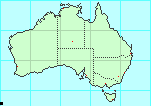
Common Name:
Delete this section if there is no common name.
Identification:
Length:
Coloring:
Note any distinguishing features.
Caput: nutans, maxillosum, palpis quatuor ad maxillas.
Antennæ setaceæ.
Alæ deflexæ: superiores flexiles, submembranaceæ.
Pedes: saltatorii plerisque.
Thorax elongatus, sublinearis.
Pedes antici remotissimi a reliquis.
Thorace denticulato, femoribus ovatis membranaceis.
Abdomen ovatum, membranaceo-planum. Elytra virescentia,
facie foliorum lauri, parallela.
(from Linnaeus 1758)
|
Head: bent down, maxillosum, palps not near maxillas.
Antennæ gradually tapering to the tip.
Wings: turned aside, upper part pliant, almost thin.
Tarsi: generally adapted for leaping.
Thorax elongated, almost straight.
Anterior tarsi have the terminal segment shortened.
The thorax has tubercles, the femurs have thin expansions.
The abdomen has thin flat expansions,
the fore wings are green,
the face has parallel leaves on the crown.
(Tentative translation by P.Miller.)
|
Viride; (capite thoraceque brunneis); alis albido-hyalinis.
- Long. ant. male corp. 2'' 8'''. Exp. alar. 3'' 8'''.
female Long. corp. 4'' 2'''. Exp. corp. 4½'''.
- Long. corp. 3'' 5'''. Exp. corp. 1'' 2'''.
- Long. corp. 3'' 3'''. Exp. corp. 1'' 6'''.
- Long. corp. 3'' 2''' *. Exp. corp. 1'' 7½'''.
(from Gray 1835)
male and female brachypterous
(from Balderson et
al 1998)
 Note parental placement of eggs.
Note appearance of eggs.
Note any common variations.
Note parental placement of eggs.
Note appearance of eggs.
Note any common variations.
Habitat:
arborial
Note typical vegetation, e.g.
tropical rainforest, temperate rainforest,
grasslands,
alpine, etc.
Similar Species:
Notes on Rearing:
Note if this species has ever been cultivated.
Note any suggestions for successful husbandry.
PSG notes indicate the following foodplants have been used successfully
in captivity: Bramble, Oak.
For a stick insect with body length 106mm, to keep 2 adult females,
you need a cage at least 500mm high, 250mm deep and 250mm wide.
 Range:
Range:
NE coastal QLD
Extralimital: India, SE Asia.
Status:
The australian representatives of this species may be extinct.
(Balderson, 1998)
References
-
Balderson, J., Rentz,
D.C.F. and Roach, A.M.E. (1998).
in
Houston, W.K.K. & Wells, A. (1998) (eds)
Zoological Catalogue of Australia.
Vol. 23.
Archaeognatha, Zygentoma, Blattodea, Isoptera, Mantodea, Dermaptera,
Phasmatodea, Embioptera, Zoraptera.
Melbourne: CSIRO Publishing, Australia (ISBN 0643 06035 9).
pp. 347 - 376.
-
Bradley, J.C., and Galil, B.S. (1977).
The taxonomic arrangement of the Phasmatodea with keys to the subfamilies
and tribes.
Proceedings of the Entomological Society of Washington,
79(2): 176-208.
-
Clark, J.T. (1976).
The eggs of stick insects (Phasmida): a review with
descriptions of the eggs of eleven species.
Syst. Ent. 1: 95-105.
-
Gray, G.R. (1835).
‘Synopsis of the Species of Insects Belonging to
the Family of Phasmidae.’ 48pp.
(Longman, Rees, Orme, Brown, Green and Longman: London.)
-
Kirby, Rev. W. and Spence, W. (1818b).
An Introduction to Entomology: or
Elements of the Natural History of Insects. 8vo. London.
4 vols. illustr.
Volume Two
-
Kirby, Rev. W. and Spence, W. (1826a).
An Introduction to Entomology: or
Elements of the Natural History of Insects. 8vo. London.
4 vols. illustr.
Volume Three
-
Latreille, P.A. (1817).
Les Crustacés, Les Arachnides et Les Insectes,
being volume three of
Cuvier, G.L.C.F.D. (1817).
Le Régne animal distribué d'après son Organisation,
pour servir de Base à l'Histoire naturelle des Animaux et d'Introduction
à l'Anatomie comparée. Five volumes. Paris.
-
Linnaeus, C. (1758).
'Systema Naturae per regna tria naturæ secondum
classes, ordines, genera, species, cum characteribus, differentilis,
synonymis, locis.' Ex. X (I), 823 pp. (Laurentii Salvii: Holmiæ.)
-
Tepper, J.G.O. (1902).
List of the Described Genera and Species of the Australian and Polynesian
Phasmidæ (Spectre-Insects).
Transactions of the Royal Society of South Australia, 26: 278-287.
-
Vickery, V.R. (1983).
Catalogue of Australian stick insects (Phasmida,
Phasmatodea, Phasmatoptera, or Cheleutoptera). CSIRO
Australian Division of Entomology Technical Paper, No. 20, 15 pp.
Phasmid Study Group
This is PSG species 76.
Web Links
Synonyms:
-
Gryllus siccifolius Linnaeus,
1758
-
Mantis siccifolia Fabr.
-
Phasma citrifolium Licht.
-
Phasma siccifolia Stoll
-
Phyllium brevicorne Latr.
-
Pteropus siccifolius Thunb.
Copyright © 2000-2003
Peter Miller
This page was last changed 20-Sep-2006.
|

|

|
 Note parental placement of eggs.
Note appearance of eggs.
Note any common variations.
Note parental placement of eggs.
Note appearance of eggs.
Note any common variations.

 Note parental placement of eggs.
Note appearance of eggs.
Note any common variations.
Note parental placement of eggs.
Note appearance of eggs.
Note any common variations.
 Range:
Range: 
